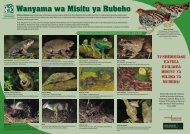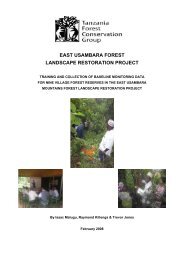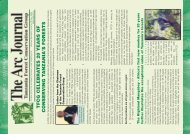Assessment of the biological values of different land cover types in ...
Assessment of the biological values of different land cover types in ...
Assessment of the biological values of different land cover types in ...
You also want an ePaper? Increase the reach of your titles
YUMPU automatically turns print PDFs into web optimized ePapers that Google loves.
Table 26. List plant species used by local communities <strong>in</strong> <strong>the</strong> Kwatango <strong>land</strong>scape.<br />
Local name Scientific/Englis name Land use type Use<br />
Mbambak<strong>of</strong>i Afzelia quanzensis Forest and Agr<strong>of</strong>orest Timber<br />
Mkenge Albizia versicolor Forest and Agr<strong>of</strong>orest Timber and local medic<strong>in</strong>es – treat<br />
chest problems and “kambaku”<br />
Mn<strong>in</strong>ga Pterocarpus t<strong>in</strong>ctorius Forest and Agr<strong>of</strong>orest Timber and Poles<br />
Mvule Milicia excelsa Forest and Agr<strong>of</strong>orest Timber<br />
Mitiki Tectona grandis, teak Plantation and Agr<strong>of</strong>orest Timber and Poles<br />
Mgude Sterculia appendiculata Forest and Agr<strong>of</strong>orest Timber<br />
Mpopote Unknown sp. Forest and Agr<strong>of</strong>orest Timber<br />
Khozandoghoi Spectranthus sp Old fallow <strong>land</strong>s Roots used to treat <strong>in</strong>test<strong>in</strong>al worms<br />
Mzughwa Trilepisium<br />
Agr<strong>of</strong>orest For treat<strong>in</strong>g malaria<br />
madagascariensis<br />
Mtura Solanum <strong>in</strong>canum Agr<strong>of</strong>orest For treat<strong>in</strong>g stomach problems<br />
Mhasha Vernonia myriantha Agr<strong>of</strong>orest For treat<strong>in</strong>g chest problems.<br />
Mwengee Unknown sp. ? For treat<strong>in</strong>g sores/ulcers<br />
Mjavikazi Unknown sp. Forest reserve Roots used to treat men‟s sexual<br />
hormonal problems<br />
Mfleta and Albizia an<strong>the</strong>lm<strong>in</strong>tica Agr<strong>of</strong>orest For treat<strong>in</strong>g body tiredness<br />
Msaji Senna siamea Agr<strong>of</strong>orest For treat<strong>in</strong>g body tiredness<br />
Mwaroba<strong>in</strong>i Azadirachta <strong>in</strong>dica Agr<strong>of</strong>orest For treat<strong>in</strong>g malaria and pesticide<br />
6.3.6 Most impotant <strong>in</strong>come generat<strong>in</strong>g tree-based products and services <strong>in</strong> Kwatango<br />
Timber, poles and fuelwood were <strong>the</strong> most frequently traded products with<strong>in</strong> <strong>the</strong> village and outside (table 26).<br />
Accord<strong>in</strong>g to <strong>the</strong> respondents, mitiki (Tectona grandis), mkenge (Albizia vescolar), mvule (Milicia excelsa),<br />
mn<strong>in</strong>gamaji (Pterocarpus t<strong>in</strong>ctorius), mbambak<strong>of</strong>i (Afzelia quanzensis), mpopote and mgule (Sterculia<br />
appendiculata) were among <strong>the</strong> species traded <strong>in</strong> <strong>the</strong>ir area.<br />
The price for timber was reported to vary depend<strong>in</strong>g on <strong>the</strong> type and size <strong>of</strong> <strong>the</strong> timber. Generally, <strong>the</strong>y stated<br />
<strong>the</strong> price to range from Tshs 2,000 to Tshs 3,000 per 10 ft piece. For poles, <strong>the</strong> price ranged from Tshs 1,000<br />
to Tshs 2,000. The price for fuelwood was reported to vary from 3,000 – 3,500 per cubic metre.<br />
6.4 Discussion<br />
The communities <strong>in</strong> <strong>the</strong> three village <strong>land</strong>scapes <strong>of</strong> Misalai, Shambangeda and Kwatango depend on many<br />
tree-based products and services. The tree-based products obta<strong>in</strong>ed from village <strong>land</strong>scapes <strong>in</strong>clude local<br />
medic<strong>in</strong>es, timber, poles, fuelwoods, fruits and vegetables. A total <strong>of</strong> 56 species were mentioned by<br />
respondents from <strong>the</strong> three villages. Of <strong>the</strong>se only one species, Trilepsium madagascariensis was mentioned<br />
as be<strong>in</strong>g used <strong>in</strong> all three villages and 13 species were mentioned by respondents <strong>in</strong> two villages.<br />
Most species are collected from agforest plots. This <strong>in</strong>cludes patches <strong>of</strong> natural vegetation with<strong>in</strong> <strong>the</strong> mosaic <strong>of</strong><br />
agricultural <strong>land</strong> as well as areas where trees have been planted. Thirty species were mentioned as be<strong>in</strong>g<br />
used from forests <strong>of</strong> which five species were only collected from forests whilst <strong>the</strong> rest were also found <strong>in</strong><br />
„agr<strong>of</strong>orest‟ areas. Of those species that are only sourced from <strong>the</strong> village forest reserve, three are used as<br />
medic<strong>in</strong>es and two provide fruits. The results highlight <strong>the</strong> importance <strong>of</strong> <strong>the</strong> rema<strong>in</strong><strong>in</strong>g natural vegetation<br />
with<strong>in</strong> <strong>the</strong> agricultural mosaic as a source <strong>of</strong> timber and non-timber forest products <strong>in</strong>clud<strong>in</strong>g medic<strong>in</strong>al plants<br />
and food.<br />
37






